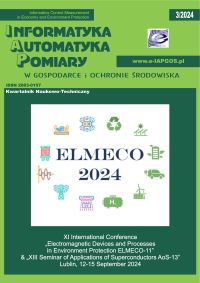SEGMENTACJA OBRAZÓW WIELOGRADACYJNYCH NA PODSTAWIE CECH ŁĄCZNOŚCI PRZESTRZENNEJ
Leonid Timchenko
tumchenko_li@gsuite.duit.edu.uaState University of Infrastructure and Technology, Artificial Intelligence Systems and Telecommunication Technologies Department (Ukraina)
https://orcid.org/0000-0001-5056-5913
Natalia Kokriatskaya
State University of Infrastructure and Technology, Artificial Intelligence Systems and Telecommunication Technologies Department (Ukraina)
https://orcid.org/0000-0003-0090-3886
Volodymyr Tverdomed
1State University of Infrastructure and Technology, Artificial Intelligence Systems and Telecommunication Technologies Department, 2Kyiv Institute of Railway Transport (Ukraina)
http://orcid.org/0000-0002-0695-1304
Oleksandr Stetsenko
State University of Infrastructure and Technology, Artificial Intelligence Systems and Telecommunication Technologies Department (Ukraina)
http://orcid.org/0000-0001-8359-0218
Valentina Kaplun
Vinnytsia National Technical University (Ukraina)
http://orcid.org/0000-0003-4353-3694
Oleg K. Kolesnytskyj
Vinnytsia National Technical University (Ukraina)
http://orcid.org/0000-0003-0336-4910
Oleksandr Reshetnik
Vinnytsia National Technical University (Ukraina)
http://orcid.org/0009-0006-7320-329X
Saule Smailova
D.Serikbayev East Kazakhstan State Technical University (Kazachstan)
http://orcid.org/0000-0002-8411-3584
Ulzhalgas Zhunissova
Astana Medical University (Kazachstan)
http://orcid.org/0000-0001-5255-9314
Abstrakt
Artykuł ma na celu zbadanie procesu wielopoziomowego segmentacji obrazów o dowolnej konfiguracji i rozmieszczeniu w oparciu o cechy łączności przestrzennej. Przeanalizowano istniejące algorytmy przetwarzania obrazu oraz określono ich zalety i wady. Opracowano metodę organizacji procesu segmentacji wielogradacyjnych obrazów półtonowych i przedstawiono algorytm działań zgodnie z opisaną metodą.
Słowa kluczowe:
segmentacja obrazu, przetwarzanie obrazu, obrazy półtonowe, łączność przestrzennaBibliografia
Avrunin O. G. et al.: Features of image segmentation of the upper respiratory tract for planning of rhinosurgical surgery. 2019 IEEE 39th International Conference on Electronics and Nanotechnology, ELNANO 2019, 485–488.
DOI: https://doi.org/10.1109/ELNANO.2019.8783739
Google Scholar
Avrunin O. G. et al.: Research Active Posterior Rhinomanometry Tomography Method for Nasal Breathing Determining Violations. Sensors 21, 2021, 8508 [http://doi.org/10.3390/s21248508].
DOI: https://doi.org/10.3390/s21248508
Google Scholar
Bradski G., Kaehler A.: Learning Open CV, second edition. 2013.
Google Scholar
Burgener F. et al.: Differential Diagnosis in Computed Tomography, 2011.
DOI: https://doi.org/10.1055/b-002-76304
Google Scholar
Campbell J.: Human Medical Thermography, 2022.
DOI: https://doi.org/10.1201/9781003281764
Google Scholar
Comaniciu D., Meer P.: Mean shift analysis and applications. IEEE International Conference on Computer Vision 2, 1999, 1197.
DOI: https://doi.org/10.1109/ICCV.1999.790416
Google Scholar
Comaniciu D., Meer P.: Mean Shift: A Robust Approach Toward Feature Space Analysis. IEEE Transactions on Pattern Analysis and Machine Intelligence, 2002, 603–619.
DOI: https://doi.org/10.1109/34.1000236
Google Scholar
Comaniciu D., Ramesh V., Meer P.: Real-Time Tracking of Non-Rigid Objects Using Mean Shift. Conference on CVPR 2, 2000, 1–8.
Google Scholar
Gonzalez R., Woods R: Digital Image Processing. Technosphere, 2012.
Google Scholar
Haralik R. M.: Statistical and structural approaches to the description of textures. Proceedings of the Institute of Electronics and Radio Engineering, 1979, 98–120.
Google Scholar
Kurmi Y., Chaurasia V.: Multifeature-based medical image segmentation. Sensors, 2018.
DOI: https://doi.org/10.1049/iet-ipr.2017.1020
Google Scholar
Linda G. S. Stockman G. C.: Computer Vision, 2001.
Google Scholar
Orazayeva A. et al.: Biomedical image segmentation method based on contour preparation. Proc. SPIE 12476, 2022, 1247605 [http://doi.org/10.1117/12.2657929].
DOI: https://doi.org/10.1117/12.2657929
Google Scholar
Rodriguez-Lozano F. J., León-García F., Ruiz de Adana M., Palomares J. M., Olivares J.: Non-Invasive Forehead Segmentation in Thermographic Imaging. Sensors 19, 2019, 4096 [http://doi.org/10.3390/s19194096].
DOI: https://doi.org/10.3390/s19194096
Google Scholar
Romanyuk O. N.: A function-based approach to real-time visualization using graphics processing units. Proc. SPIE 11581, 2020, 115810E [http://doi.org/10.1117/12.2580212].
Google Scholar
Rother С., Kolmogorov V., Blake Grabcut A.: Interactive foreground extraction using iterated graph cuts, 2004.
DOI: https://doi.org/10.1145/1186562.1015720
Google Scholar
Timchenko L. I. et al.: Q-processors for real-time image processing. Proc. SPIE 11581, 2020, 115810F [http://doi.org/10.1117/12.2580230].
Google Scholar
Timchenko L. I., Kutaev Y. F.: Method and organization of image extraction. Patent 2024939С1 RF, MKI G 06 K 9/00, 1992-07-08, 1992.
Google Scholar
Vapnik V.N., Chervonenkis A.Y.: Pattern recognition theory (statistical learning problems). Science, 1974.
Google Scholar
Wójcik W., Smolarz A.: Information Technology in Medical Diagnostics (1st ed.). CRC Press 2017 [http://doi.org/10.1201/9781315098050].
DOI: https://doi.org/10.1201/9781315098050
Google Scholar
Autorzy
Leonid Timchenkotumchenko_li@gsuite.duit.edu.ua
State University of Infrastructure and Technology, Artificial Intelligence Systems and Telecommunication Technologies Department Ukraina
https://orcid.org/0000-0001-5056-5913
Autorzy
Natalia KokriatskayaState University of Infrastructure and Technology, Artificial Intelligence Systems and Telecommunication Technologies Department Ukraina
https://orcid.org/0000-0003-0090-3886
Autorzy
Volodymyr Tverdomed1State University of Infrastructure and Technology, Artificial Intelligence Systems and Telecommunication Technologies Department, 2Kyiv Institute of Railway Transport Ukraina
http://orcid.org/0000-0002-0695-1304
Autorzy
Oleksandr StetsenkoState University of Infrastructure and Technology, Artificial Intelligence Systems and Telecommunication Technologies Department Ukraina
http://orcid.org/0000-0001-8359-0218
Autorzy
Valentina KaplunVinnytsia National Technical University Ukraina
http://orcid.org/0000-0003-4353-3694
Autorzy
Oleg K. KolesnytskyjVinnytsia National Technical University Ukraina
http://orcid.org/0000-0003-0336-4910
Autorzy
Oleksandr ReshetnikVinnytsia National Technical University Ukraina
http://orcid.org/0009-0006-7320-329X
Autorzy
Saule SmailovaD.Serikbayev East Kazakhstan State Technical University Kazachstan
http://orcid.org/0000-0002-8411-3584
Autorzy
Ulzhalgas ZhunissovaAstana Medical University Kazachstan
http://orcid.org/0000-0001-5255-9314
Statystyki
Abstract views: 119PDF downloads: 128
Licencja

Utwór dostępny jest na licencji Creative Commons Uznanie autorstwa – Na tych samych warunkach 4.0 Miedzynarodowe.
Inne teksty tego samego autora
- Nataliia Kozan, Oleksandr Saleha, Olexander Dubolazov, Yuriy Ushenko, Iryna Soltys, Oleksandr Ushenko, Oleksandr Olar, Victor Paliy, Saule Smailova, MAPOWANIE POLARYZACYJNO-KORELACYJNE OBRAZÓW MIKROSKOPOWYCH TKANEK BIOLOGICZNYCH O RÓŻNEJ STRUKTURZE MORFOLOGICZNEJ , Informatyka, Automatyka, Pomiary w Gospodarce i Ochronie Środowiska: Tom 14 Nr 3 (2024)
- Leonid Timchenko, Natalia Kokriatskaia, Volodymyr Tverdomed, Anatolii Horban, Oleksandr Sobovyi, Liudmyla Pogrebniak, Nelia Burlaka, Yurii Didenko, Maksym Kozyr, Ainur Kozbakova, NEUROBIOLOGICZNE WŁAŚCIWOŚCI STRUKTURY SIECI RÓWNOLEGŁO-HIERARCHICZNEJ I JEJ WYKORZYSTANIE DO ROZPOZNAWANIA WZORCÓW , Informatyka, Automatyka, Pomiary w Gospodarce i Ochronie Środowiska: Tom 14 Nr 3 (2024)








